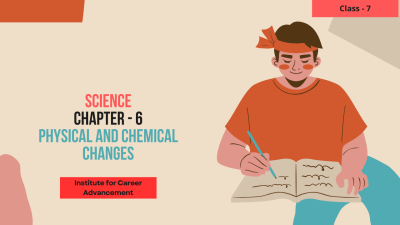Course description
Here's an overview of what students typically learn about physical and chemical changes:
Physical Changes:
Definition:
Physical changes are alterations in the physical state or appearance of a substance without changing its chemical composition.
These changes can include changes in state (solid, liquid, gas), size, shape, or form.
Examples:
Melting ice into water.
Freezing water into ice.
Cutting paper into smaller pieces.
Dissolving sugar in water.
Crushing a can.
Characteristics:
Reversibility: Physical changes can often be reversed by simple physical processes (e.g., melting and freezing).
No New Substance: The substance involved remains the same before and after the change; only its appearance or state has changed.
Importance:
Understanding physical changes helps students recognize how substances can transform without altering their fundamental chemical properties.
It is essential in everyday contexts such as cooking, manufacturing, and various crafts.
Application:
Physical changes are utilized in industries where materials undergo shaping, resizing, or transformation without undergoing chemical reactions.
Experiments and Demonstrations:
Simple experiments and demonstrations illustrate physical changes, such as freezing water into ice cubes or evaporating water to obtain salt.
Chemical Changes:
Definition:
Chemical changes (or chemical reactions) involve the formation of new substances with different chemical properties from the original substances.
Bonds between atoms are broken and new bonds are formed, resulting in a chemical transformation.
Examples:
Rusting of iron (iron + oxygen → iron oxide).
Burning of wood (wood + oxygen → carbon dioxide + water + ash).
Digestion of food in the body (complex molecules → simpler molecules).
Characteristics:
Irreversibility: Chemical changes are usually irreversible under normal conditions.
Formation of New Substances: New substances with different properties are formed as a result of chemical reactions.
Importance:
Understanding chemical changes is crucial in explaining many natural processes, industrial processes, and biological functions.
It forms the basis for understanding reactions in fields such as medicine, agriculture, and environmental science.
Application:
Chemical changes are central to industries such as pharmaceuticals, food processing, and manufacturing of various chemicals and materials.
শিক্ষার্থীরা সাধারণত শারীরিক এবং রাসায়নিক পরিবর্তন সম্পর্কে কী শিখে তার একটি সংক্ষিপ্ত বিবরণ এখানে দেওয়া হল:
শারিরীক পরিবর্তন:
সংজ্ঞা:
দৈহিক পরিবর্তন হল রাসায়নিক গঠন পরিবর্তন না করেই পদার্থের শারীরিক অবস্থা বা চেহারায় পরিবর্তন।
এই পরিবর্তনগুলির মধ্যে অবস্থার পরিবর্তন (কঠিন, তরল, গ্যাস), আকার, আকৃতি বা ফর্ম অন্তর্ভুক্ত থাকতে পারে।
উদাহরণ:
জলে বরফ গলছে।
বরফে পরিণত হওয়া জল।
ছোট ছোট টুকরা কাগজ কাটা.
পানিতে চিনি দ্রবীভূত করা।
একটি ক্যান চূর্ণ.
বৈশিষ্ট্য:
প্রত্যাবর্তনযোগ্যতা: শারীরিক পরিবর্তনগুলি প্রায়শই সাধারণ শারীরিক প্রক্রিয়াগুলির দ্বারা বিপরীত হতে পারে (যেমন, গলে যাওয়া এবং হিমায়িত হওয়া)।
কোন নতুন পদার্থ নেই: জড়িত পদার্থ পরিবর্তনের আগে এবং পরে একই থাকে; শুধুমাত্র তার চেহারা বা অবস্থা পরিবর্তিত হয়েছে.
গুরুত্ব:
শারীরিক পরিবর্তনগুলি বোঝা ছাত্রদের বুঝতে সাহায্য করে যে কীভাবে পদার্থগুলি তাদের মৌলিক রাসায়নিক বৈশিষ্ট্যগুলি পরিবর্তন না করে রূপান্তরিত হতে পারে।
রান্না, উত্পাদন এবং বিভিন্ন কারুশিল্পের মতো দৈনন্দিন প্রসঙ্গে এটি অপরিহার্য।
আবেদন:
শারীরিক পরিবর্তনগুলি শিল্পগুলিতে ব্যবহার করা হয় যেখানে রাসায়নিক বিক্রিয়া ছাড়াই উপকরণগুলি আকৃতি, আকার পরিবর্তন বা রূপান্তরিত হয়।
পরীক্ষা এবং প্রদর্শন:
সাধারণ পরীক্ষা এবং প্রদর্শনগুলি শারীরিক পরিবর্তনগুলিকে চিত্রিত করে, যেমন জলকে বরফের কিউবগুলিতে জমা করা বা লবণ পাওয়ার জন্য জলকে বাষ্পীভূত করা।
রাসায়নিক পরিবর্তন:
সংজ্ঞা:
রাসায়নিক পরিবর্তন (বা রাসায়নিক বিক্রিয়া) মূল পদার্থ থেকে ভিন্ন রাসায়নিক বৈশিষ্ট্য সহ নতুন পদার্থের গঠন জড়িত।
পরমাণুর মধ্যে বন্ধন ভেঙে যায় এবং নতুন বন্ধন তৈরি হয়, যার ফলে রাসায়নিক রূপান্তর হয়।
উদাহরণ:
লোহার মরিচা (লোহা + অক্সিজেন → আয়রন অক্সাইড)।
কাঠ পোড়ানো (কাঠ + অক্সিজেন → কার্বন ডাই অক্সাইড + জল + ছাই)।
শরীরে খাদ্য হজম হয় (জটিল অণু → সরল অণু)।
বৈশিষ্ট্য:
অপরিবর্তনীয়তা: রাসায়নিক পরিবর্তন সাধারণত স্বাভাবিক অবস্থায় অপরিবর্তনীয় হয়।
নতুন পদার্থের গঠন: রাসায়নিক বিক্রিয়ার ফলে বিভিন্ন বৈশিষ্ট্যযুক্ত নতুন পদার্থ তৈরি হয়।
গুরুত্ব:
রাসায়নিক পরিবর্তন বোঝা অনেক প্রাকৃতিক প্রক্রিয়া, শিল্প প্রক্রিয়া এবং জৈবিক ফাংশন ব্যাখ্যা করার জন্য অত্যন্ত গুরুত্বপূর্ণ।
এটি ওষুধ, কৃষি এবং পরিবেশ বিজ্ঞানের মতো ক্ষেত্রে প্রতিক্রিয়া বোঝার ভিত্তি তৈরি করে।
আবেদন:
রাসায়নিক পরিবর্তনগুলি ফার্মাসিউটিক্যালস, খাদ্য প্রক্রিয়াকরণ এবং বিভিন্ন রাসায়নিক ও উপকরণ তৈরির মতো শিল্পের কেন্দ্রবিন্দু।



















